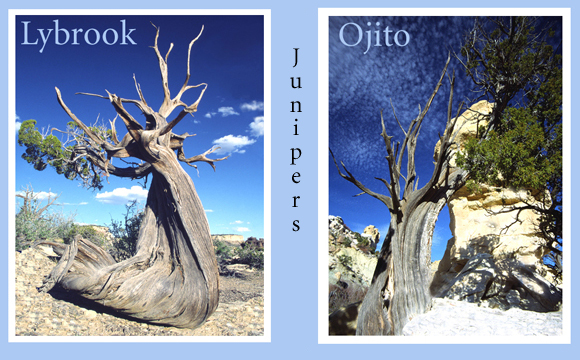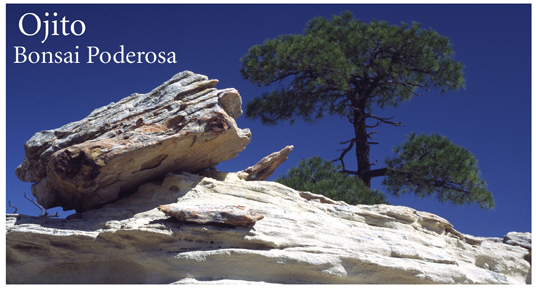
HIGH DESERT TREES Click here for slide show version!
Badlands are primarily about hoo doos but New Mexico’s incredible high desert vegetation runs a very close second. The 3 Fruitland/Kirtland badlands, Bisti, Ah Shi Sle Pah and De Na Zin , are mostly devoid of plant life. Shallow, hard-packed, sun-baked, alkaline or salty soils shed water, discourage fragile seedlings, and make it difficult for root systems to get established. The other 6 badlands however, have more varied topography conducive to rich, diverse plant communities. Sandstone cliffs provide shade and channel water to protected box canyons where soil can accumulate. Beautifully xeriscaped sculpture parks, Ojito, Ceja Pelon, Penistaja Mesa, Lybrook, Mesa De Cuba, and San Jose, showcase the elegant strength and alluring optimism of the high desert flora. Hardy scrub oaks, flowering desert shrubs, blooming cacti, grasses that green up immediately following rain, even moss and lichens in areas of fragile cryptogrammic soil mark the seasons and celebrate the summer monsoons. Character laden old junipers, pinyons and ponderosa have the ultimate star power. Both junipers and pinyons are equally at home in these 6000-7500 feet elevations, but for some reason the oldest, biggest individuals of the two types are usually junipers. They may be better able to survive serious droughts and insect epidemics that have periodically swept across the high desert for thousands of years. The most picturesque junipers grow from bare rock . Their gnarled roots claw at naked cliff edges anchoring huge, sinuous trunks flowing like the rippling strata from which they grow. Sometimes only one small portion of green needles remains on the entire network of stark branches, and yet the tree lives on. On the other hand, badlands’ ponderosa struggle at the lower edge of their survival range. They prefer mountains and mesa tops above 7500 feet where it’s a bit cooler and wetter. As such they provide the most heart warming drama and beauty found in the high desert. Stunted, twisted “Bonsai Ponderosa”, fighting for survival in a foreign environment, offer graphic testimony to life’s amazing adaptability and tenacity. Ojito and Lybrook are the best places to see these heroic desert survivors.
BONSAI PONDEROSA Ojito’s bonsai ponderosa form an isolated population out of their range at a much too low elevation. Averaging only 20 feet or so in height, they display the same branching, compact stature as their pinyon and juniper neighbors rather than the tall, straight stance of their mountain relatives. Exceedingly rare at these elevations and somewhat of an ecological mystery, perhaps they are refugees from moister times in the distant past. Maybe tree ring dating would help solve the puzzle, but whatever the answer, they add special character to the ascetic Ojito landscapes.Lybrook’s higher elevations and varied topography include shady, well-watered canyon bottoms where a few ponderosas can mature into the usual tall, thick-trunked, ramrod straight sentinels. While not far above on exposed cliff edges grow the most amazing bonsai ponderosa trees I’ve ever seen. No where is the battle for survival in the high desert more poignant. The closer the trees grow to the edge the more twisted and stunted they become. Often clawing at the rock and life by just one root, these struggling trees writhe with determination as they test every strategy to postpone inevitable death while their world erodes away. Lightening bolts have scarred many, as if wind, scare water, bare rock and searing sun don’t offer enough challenges. Nearby their downed skeletons, with intricate grain patterns embossed by a patina of time and the elements, seem almost as beautiful as the ones who struggle on.
|
||||||||||||||||||||||||||||||||||||||||||||||||||||||||||||||||||||||||||||||||||||||||||||||||||
|
| HOME |
GEOLOGY |
PHOTOGRAPHY TIPS | RECREATION | MAP - INDIVIDUAL BADLANDS |
| INDIVIDUAL BADLANDS PAGE | PHOTO TOURS |
BADLANDS OVERVIEW |
This site is property of PhotoTrekNM. All rights reserved. Copyright 2007.
embed.jpg)


_jpg.jpg)
_jpg.jpg)
_jpg.jpg)
_jpg.jpg)
_jpg.jpg)
_jpg.jpg)
_jpg.jpg)
_jpg.jpg)
_jpg.jpg)
_jpg.jpg)
_jpg.jpg)
_jpg.jpg)
_jpg.jpg)
_jpg.jpg)
_jpg.jpg)
_jpg.jpg)
_jpg.jpg)
_jpg.jpg)
_jpg.jpg)
_jpg.jpg)
_jpg.jpg)
_jpg.jpg)
_jpg.jpg)
_jpg.jpg)
_jpg.jpg)
_jpg.jpg)
_jpg.jpg)
_jpg.jpg)
_jpg.jpg)
_jpg.jpg)
_jpg.jpg)
_jpg.jpg)
_jpg.jpg)
_jpg.jpg)
_jpg.jpg)
_jpg.jpg)
_jpg.jpg)
_jpg.jpg)
_jpg.jpg)
_jpg.jpg)
_jpg.jpg)
_jpg.jpg)
_jpg.jpg)
_jpg.jpg)
_jpg.jpg)
_jpg.jpg)
_jpg.jpg)
_jpg.jpg)
_jpg.jpg)
_jpg.jpg)
_jpg.jpg)
_jpg.jpg)
_jpg.jpg)
_jpg.jpg)
_jpg.jpg)
_jpg.jpg)
_jpg.jpg)
_jpg.jpg)
_jpg.jpg)
_jpg.jpg)
_jpg.jpg)
_jpg.jpg)
_jpg.jpg)
_jpg.jpg)
_jpg.jpg)
_jpg.jpg)
_jpg.jpg)
_jpg.jpg)
_jpg.jpg)
_jpg.jpg)
_jpg.jpg)
_jpg.jpg)
_jpg.jpg)
_jpg.jpg)
_jpg.jpg)
_jpg.jpg)
_jpg.jpg)
_jpg.jpg)
_jpg.jpg)
_jpg.jpg)
_jpg.jpg)
_jpg.jpg)
_jpg.jpg)
_jpg.jpg)
_jpg.jpg)
_jpg.jpg)
_jpg.jpg)
_jpg.jpg)
_jpg.jpg)
_jpg.jpg)
_jpg.jpg)
_jpg.jpg)
_jpg.jpg)
_jpg.jpg)
_jpg.jpg)
_jpg.jpg)
_jpg.jpg)
